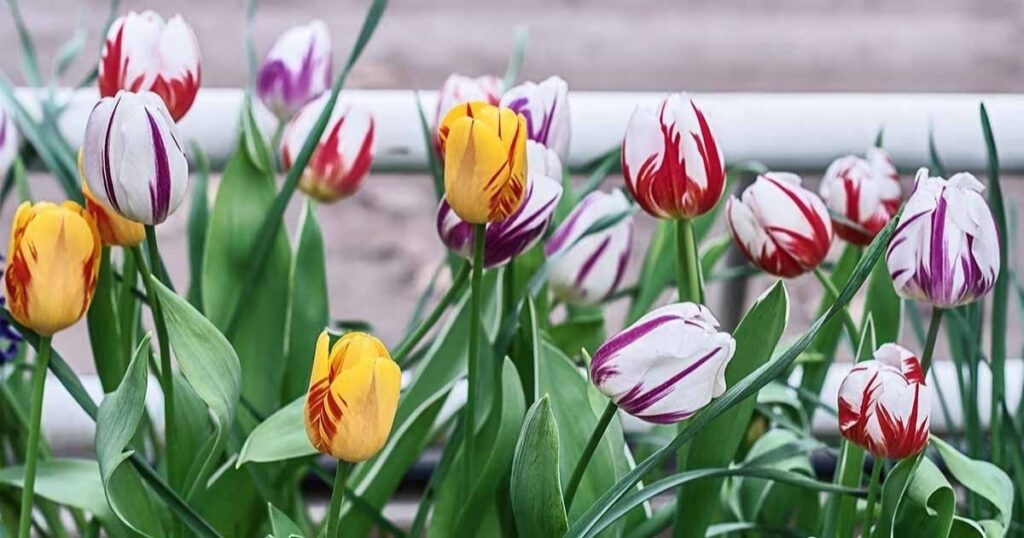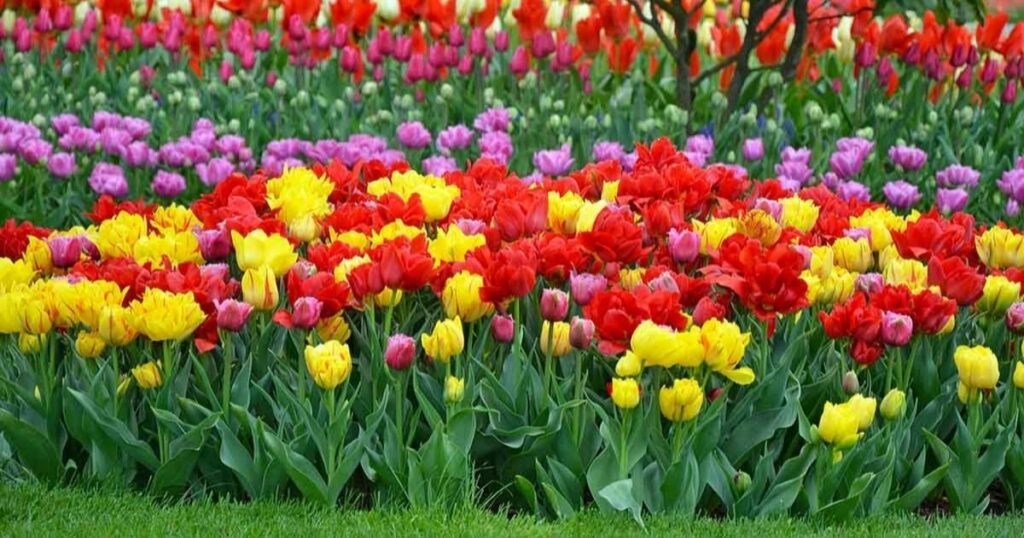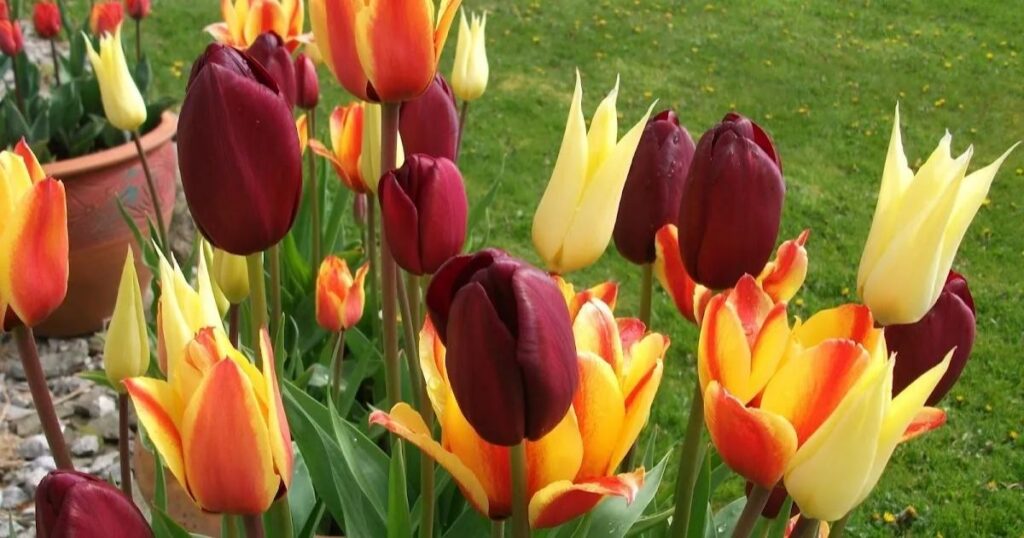Tulips are one of the most beloved spring flowers, known for their vibrant colors and elegant shape. These iconic blooms have captivated gardeners and flower enthusiasts for centuries. But one question that often arises is: how long do tulips bloom?
In this comprehensive guide, we’ll explore the factors that influence tulip bloom duration, from the moment they emerge from the ground to their final petal drop. We’ll also delve into the care and maintenance of both gardens and cut tulips, helping you maximize their beauty throughout the blooming season.
When Do Tulips Bloom?
Understanding when tulips bloom is crucial for gardeners and flower lovers alike. The timing of tulip blooms depends on various factors, including the specific variety, geographic location, planting time, and weather conditions. Let’s explore these aspects in detail to give you a clear picture of when you can expect your tulips to grace your garden with their colorful presence.
Varieties and Bloom Time
Tulip varieties play a significant role in determining when these flowers will bloom. With over 3,000 registered cultivars, tulips offer a wide range of blooming times, allowing gardeners to enjoy these beautiful flowers for an extended period. Tulip varieties are generally categorized into early, mid-season, and late-blooming groups:
Early-blooming tulips: These varieties typically flower in late winter to early spring, often alongside other early spring bulbs like crocuses and daffodils. Examples include:
- Single Early tulips
- Double Early tulips
- Kaufmanniana tulips (also known as Waterlily tulips)
- Fosteriana tulips (also called Emperor tulips)
Mid-season blooming tulips: These usually bloom in mid-spring, taking center stage in the garden. Popular mid-season varieties include:
- Triumph tulips
- Darwin Hybrid tulips
- Greigii tulips
Late-blooming tulips: These varieties extend the tulip season into late spring and even early summer in some regions. Late-blooming tulips include:
- Single Late tulips
- Double Late tulips
- Lily-flowered tulips
- Parrot tulips
- Viridiflora tulips
By selecting a mix of early, mid-season, and late-blooming tulip varieties, you can create a stunning display that lasts for several weeks or even months.
Geographic Factors
The geographic location of your garden plays a crucial role in determining when tulips will bloom. Tulips are native to regions with cold winters and warm springs, and they’ve been cultivated to thrive in similar climates around the world. Here’s how geography affects tulip bloom timing:
Climate zones: In general, tulips bloom earlier in warmer climate zones and later in cooler zones. For example:
- In USDA Hardiness Zones 3-5 (colder regions), tulips typically bloom from mid-April to mid-May.
- In Zones 6-7, blooming often occurs from late March to early May.
- In Zones 8-9 (warmer regions), tulips may bloom as early as February or March.
Latitude: Regions closer to the equator experience earlier springs and, consequently, earlier tulip blooms. Conversely, tulips in more northern latitudes will bloom later.
Altitude: Gardens at higher elevations typically see later tulip blooms due to cooler temperatures and the later onset of spring.
Microclimate: Even within the same geographic area, microclimates can affect bloom times. South-facing slopes or areas near heat-retaining structures may see earlier blooms than cooler, shadier spots.
Understanding your specific geographic factors can help you predict when your tulips will bloom and plan your garden accordingly.
Planting Time
The timing of tulip bulb planting significantly influences when the flowers will bloom in the following spring. Proper planting time ensures that the bulbs have enough time to establish roots before winter and undergo the necessary cold period for proper flower development. Here’s what you need to know about planting time and its impact on bloom timing:
Fall planting: In most regions, tulip bulbs are planted in the fall, typically 6-8 weeks before the ground freezes. This allows the bulbs to develop a strong root system before winter dormancy.
Timing variations:
- In colder climates (Zones 3-5), plant tulip bulbs in September or early October.
- In moderate climates (Zones 6-7), plant in October or early November.
- In warmer climates (Zones 8-9), plant in November or even December, once soil temperatures have cooled sufficiently.
Effect on bloom time: Planting at the optimal time for your region ensures that tulips will bloom at their expected time in spring. Planting too late may result in delayed or weaker blooms while planting too early in warm climates can lead to premature growth and potential frost damage.
Pre-chilled bulbs: In very warm climates where winters are too mild for tulips, gardeners can use pre-chilled bulbs. These are planted later, often in late winter, and will bloom in spring, though typically later than fall-planted bulbs in cooler regions.
By adhering to the recommended planting times for your area, you can help ensure that your tulips will bloom on schedule and with full vigor.
Impact of Weather
Weather conditions play a significant role in determining when tulips bloom and how long they last. Tulips are remarkably sensitive to temperature changes, which can accelerate or delay their blooming process. Here’s how different weather factors affect tulip bloom timing:
Also read this post:how mixing flowers with your vegetable plot
Temperature:
- Tulips require a period of cold dormancy (typically below 40°F or 4°C) to initiate proper flower development.
- Warmer-than-average winter and early spring temperatures can lead to earlier blooming.
- Conversely, a prolonged cold spell in spring can delay blooming.
Sunlight:
- Increased sunlight in early spring can speed up the growth and blooming process.
- Cloudy or overcast conditions may slightly delay blooming.
Precipitation:
- Adequate moisture is essential for tulip growth and blooming.
- Excessive rainfall can lead to waterlogged soil, potentially delaying growth or causing bulb rot.
- Drought conditions can stress the plants and affect bloom quality and timing.
Wind:
- Strong winds can damage emerging shoots and flowers, potentially delaying or diminishing blooms.
- Wind chill can slow growth in early spring.
Frost:
- Late spring frosts can damage emerging buds or open flowers, affecting bloom quality and duration.
- Some tulip varieties are more frost-resistant than others.
Temperature fluctuations:
- Rapid temperature changes can confuse tulips, potentially leading to early or erratic blooming.
- A warm spell followed by a cold snap can damage buds or flowers.
Understanding these weather impacts can help gardeners anticipate changes in bloom timing and take protective measures when necessary. For instance, covering tulip beds with frost cloth during unexpected late frosts can help preserve blooms.
By considering the variety, geographic factors, planting time, and weather conditions, you can better predict and plan for your tulips’ blooming period. This knowledge allows you to create stunning garden displays and enjoy these beautiful flowers at their peak.
How Long Do Tulips Bloom For?

One of the most common questions among tulip enthusiasts is, “How long do tulips bloom?” The answer to this question isn’t straightforward, as several factors influence the duration of tulip blooms. In this section, we’ll explore these factors in detail, helping you understand what affects tulip bloom duration and how you can potentially extend this magical period in your garden.
Tulip Variety
The specific tulip variety plays a crucial role in determining how long the flowers will bloom. Different tulip types have varying bloom durations, which can range from a few days to several weeks. Here’s a breakdown of bloom durations for some popular tulip varieties:
- Single Early and Double Early tulips: These varieties typically bloom for 1-2 weeks.
- Triumph tulips: Known for their sturdy stems, Triumph tulips usually bloom for 2-3 weeks.
- Darwin Hybrid tulips: These large, showy tulips can bloom for up to 3 weeks under ideal conditions.
- Parrot tulips: With their frilly, feathered petals, Parrot tulips generally bloom for 1-2 weeks.
- Single Late and Double Late tulips: These varieties often have a bloom period of 2-3 weeks.
- Species tulips: These wild tulip varieties are often longer-lasting, with some blooming for up to 4 weeks.
- Fringed tulips: Known for their delicate, fringed petal edges, these tulips typically bloom for 1-2 weeks.
- Lily-flowered tulips: With their elegant, pointed petals, these tulips usually bloom for about 2 weeks.
- Viridiflora tulips: Characterized by green streaks on their petals, these tulips can bloom for 2-3 weeks.
- Kaufmanniana tulips: Also known as waterlily tulips, these early bloomers can last for 1-2 weeks.
It’s important to note that these durations are general estimates and can vary based on other factors such as growing conditions and weather. By selecting a mix of early, mid-season, and late-blooming varieties, you can extend the overall tulip blooming period in your garden to several weeks or even months.
Growing Conditions
The conditions in which tulips are grown significantly impact their bloom duration. Optimal growing conditions not only promote healthier plants but can also extend the life of the flowers. Here are the key factors to consider:
Soil quality:
- Well-draining, fertile soil rich in organic matter promotes healthy tulip growth and longer-lasting blooms.
- Soil pH between 6.0 and 7.0 is ideal for most tulip varieties.
Sunlight exposure:
- Tulips generally prefer full sun to partial shade.
- In warmer climates, some afternoon shade can help prolong blooms by preventing them from overheating.
Water availability:
- Consistent moisture during the growing season is crucial for tulip health and bloom longevity.
- Overwatering can lead to bulb rot and shortened bloom time.
Nutrient levels:
- Proper fertilization, especially with phosphorus, can strengthen tulip plants and potentially extend bloom time.
- Over-fertilization, particularly with nitrogen, can lead to excessive foliage growth at the expense of flower longevity.
Planting depth:
- Proper planting depth (generally 4-6 inches deep) ensures bulbs are protected from temperature fluctuations and promotes steady growth.
Spacing:
- Adequate spacing between bulbs (typically 4-6 inches apart) allows for proper air circulation and reduces competition for resources.
Companion planting:
- Growing tulips alongside compatible plants can create microclimates that protect and potentially extend blooms.
By optimizing these growing conditions, you can help ensure that your tulips not only bloom beautifully but also maintain their flowers for as long as possible.
Weather Factors
Weather plays a significant role in determining how long tulips bloom. While we can’t control the weather, understanding its impact can help us take protective measures when necessary. Here’s how different weather factors affect tulip bloom duration:
Temperature:
- Cool temperatures (around 60-65°F or 15-18°C) can help tulip blooms last longer.
- Hot weather can cause tulips to bloom and fade more quickly.
- Sudden temperature fluctuations can stress the plants and shorten bloom time.
Sunlight:
- While tulips need sunlight to grow, intense direct sun can cause blooms to open and fade more rapidly.
- Partial shade during the hottest part of the day can help prolong blooms in warmer climates.
Rainfall:
- Moderate rainfall can benefit tulips and help maintain blooms.
- Heavy rain can damage petals and shorten bloom time.
- Drought conditions can stress plants and cause premature wilting.
Wind:
- Strong winds can damage delicate tulip petals, potentially shortening bloom duration.
- Gentle breezes can be beneficial, promoting air circulation and reducing the risk of fungal diseases.
Humidity:
- High humidity can promote fungal growth, which may affect bloom longevity.
- Very low humidity can cause flowers to dry out more quickly.
Frost:
- Late spring frosts can damage open blooms, significantly shortening their lifespan.
To mitigate adverse weather effects, consider using protective measures such as windbreaks, shade cloth, or frost covers when extreme conditions are expected. These precautions can help extend the life of your tulip blooms despite challenging weather.
Care and Maintenance
Proper care and maintenance are crucial for maximizing the bloom duration of tulips. By following best practices, you can help your tulips stay healthier and bloom longer. Here are some essential care tips:
Deadheading:
- Remove faded flowers promptly to prevent the plant from putting energy into seed production.
- This can sometimes encourage the plant to maintain its remaining blooms for a longer period.
Watering:
- Water deeply but infrequently to encourage deep root growth.
- Avoid getting water on the flowers, as this can lead to petal damage and fungal issues.
Mulching:
- Apply a layer of organic mulch around tulips to maintain soil moisture and regulate temperature.
- Mulch can also help protect bulbs from temperature fluctuations.
Protection from pests:
- Monitor for common tulip pests like aphids and slugs, and address infestations promptly.
- Use appropriate pest control methods to prevent damage to blooms and foliage.
Disease prevention:
- Practice good garden hygiene by removing dead leaves and debris.
- Ensure proper air circulation to reduce the risk of fungal diseases.
Fertilization:
- Apply a balanced, low-nitrogen fertilizer when shoots first appear and again after blooming.
- Avoid over-fertilizing, as this can lead to weak growth and shorter bloom times.
Support:
- For taller varieties, consider using stakes or other supports to prevent wind damage to stems and blooms.
Post-bloom care:
- Allow foliage to die back naturally after blooming, as this replenishes the bulb’s energy for next year’s growth.
- Avoid cutting back foliage until it has completely yellowed.
By implementing these care and maintenance practices, you can help ensure that your tulips remain healthy and vibrant, potentially extending their bloom duration.
Cut Tulips
While we often focus on tulips growing in the garden, cut tulips are also popular for indoor displays. The lifespan of cut tulips can vary, but with proper care, they can last anywhere from 5 to 12 days. Here are some factors that influence the longevity of cut tulips:
Cutting stage:
- Tulips cut when the buds are just beginning to show color but are not fully open tend to last longer in vases.
- Fully open tulips have a shorter vase life but provide immediate impact.
Cutting technique:
- Cut stems at a 45-degree angle to increase water uptake.
- Re-cut stems every few days to maintain water absorption.
Water quality:
- Use clean, cool water in vases.
- Change water every 2-3 days to prevent bacterial growth.
Vase preparation:
- Clean vases thoroughly before use to remove any bacteria.
- Consider using floral preservatives to extend bloom life.
Temperature:
- Keep cut tulips in a cool area, away from direct sunlight and heat sources.
- Cooler temperatures can slow the opening of blooms and extend their lifespan.
Stem length:
- Shorter stems generally lead to longer-lasting blooms, as the flowers require less energy to maintain.
Variety:
- Some tulip varieties naturally last longer as cut flowers than others.
By following these guidelines, you can enjoy your cut tulips for a longer period, bringing the beauty of spring indoors.
Impact of Successive Planting
For those who want to enjoy tulips for an extended period, successive planting can be an effective strategy. This technique involves planting bulbs at intervals to stagger bloom times. Here’s how successive planting can impact tulip bloom duration:
Extended overall bloom period:
- By planting early, mid-season, and late-blooming varieties at 2-week intervals, you can create a continuous display that lasts for several months.
Varied bloom times:
- Planting the same variety at different times can result in staggered blooming, extending the display of a particular color or type.
Combination with other bulbs:
- Successive planting can be combined with other spring-flowering bulbs to create
- a diverse and long-lasting spring display.
Adaptation to microclimates:
- Planting in different areas of your garden with varying sun exposure can naturally stagger bloom times.
Seasonal interest:
- Successive planting allows you to plan for continuous color throughout the spring season.
Experimentation opportunities:
- This technique allows gardeners to experiment with different combinations and timings to achieve the desired bloom sequence.
By employing successive planting techniques, you can significantly extend the overall tulip blooming period in your garden, potentially enjoying these beautiful flowers for several months rather than just a few weeks.
How Long Do Cut Tulips Last?

Cut tulips are a popular choice for floral arrangements due to their elegant shape and vibrant colors. Understanding how long cut tulips last and the factors that affect their longevity can help you enjoy these beautiful flowers for as long as possible in your home or office.
Typical Lifespan
The typical lifespan of cut tulips varies depending on several factors, but with proper care, you can expect them to last anywhere from 5 to 12 days. Here’s a breakdown of what you might expect:
- Average lifespan: Most cut tulips will last about 7-10 days with proper care.
- Early-stage cuts: Tulips cut when the buds are just beginning to show color but are not fully open can last up to 10-12 days.
- Fully open cuts: Tulips that are already in full bloom when cut typically last 5-7 days.
- Variety differences: Some tulip varieties naturally last longer as cut flowers than others. For example, double tulips often have a shorter vase life compared to single tulips.
- Care level: With meticulous care, including daily water changes and stem trims, some cut tulips can last up to two weeks.
Remember that these are general estimates, and individual results may vary based on the specific conditions and care provided.
Factors Affecting Longevity
Several factors can influence how long your cut tulips will last. Understanding these can help you take steps to maximize the lifespan of your flowers:
Cutting stage:
- Tulips cut at the “colored bud” stage (when color is visible but the flower is not fully open) tend to last longer.
- Fully open flowers have a shorter vase life but provide immediate visual impact.
Cutting technique:
- Clean, sharp cuts at a 45-degree angle increase water uptake and prolong flower life.
- Crushing or damaging the stem ends can reduce water absorption and shorten lifespan.
Storage conditions:
- Cool temperatures (around 40-45°F or 4-7°C) can significantly extend the life of cut tulips.
- Avoid placing tulips near heat sources or in direct sunlight.
Water quality:
- Clean, cool water is essential for maintaining cut tulips.
- Hard water or water with high mineral content can negatively affect flower longevity.
Bacterial growth:
- Bacteria in the water can clog stem ends and shorten flower life.
- Regular water changes and clean vases are crucial for preventing bacterial growth.
Ethylene exposure:
- Ethylene gas, produced by ripening fruits and some plants, can cause premature wilting in tulips.
- Keep cut tulips away from fruit bowls and other ethylene-producing plants.
Stem length:
- Shorter stems generally lead to longer-lasting blooms, as the flowers require less energy to maintain.
Variety:
- Some tulip varieties naturally have a longer vase life than others.
By considering these factors and implementing appropriate care techniques, you can help ensure that your cut tulips remain fresh and beautiful for as long as possible.
Water and Nutrition
Proper water and nutrition are crucial for extending the life of cut tulips. Here are some key points to consider:
Water temperature:
- Use cool water (around 40-45°F or 4-7°C) for tulips.
- Avoid using warm or hot water, as this can cause air bubbles in the stems and reduce water uptake.
Water quality:
- Use clean, fresh water to fill your vase.
- If your tap water is hard or high in minerals, consider using filtered or distilled water.
Water changes:
- Change the water every 2-3 days or when it becomes cloudy.
- Rinse the stems and vase thoroughly with each water change to remove any bacteria.
Water level:
- Keep the water level high enough to cover at least the bottom third of the stems.
- As tulips continue to grow in the vase, you may need to adjust the water level.
Floral preservatives:
- Commercial floral preservatives can help extend the life of cut tulips by providing nutrients and preventing bacterial growth.
- You can make a homemade preservative by mixing 1 teaspoon of sugar, 1 teaspoon of bleach, and 2 teaspoons of lemon or lime juice per quart of water.
Stem trimming:
- Trim about 1/2 inch off the bottom of the stems every few days to maintain water uptake.
- Make clean cuts at a 45-degree angle using sharp scissors or a knife.
Nutrition balance:
- While tulips don’t require heavy feeding, a small amount of sugar in the water can provide energy for the blooms.
- Be cautious with sugar amounts, as too much can promote bacterial growth.
By paying attention to water quality and providing appropriate nutrition, you can help your cut tulips stay fresh and vibrant for a longer period.
Environmental Conditions
The environment in which you keep your cut tulips can significantly impact their longevity. Here are some key environmental factors to consider:
Temperature:
- Keep cut tulips in a cool room, ideally between 60-65°F (15-18°C).
- Avoid placing them near heat sources like radiators, fireplaces, or sunny windows.
Light:
- Tulips prefer moderate light conditions.
- Avoid placing them in direct sunlight, which can cause them to wilt faster.
Humidity:
- Moderate humidity levels (around 40-60%) are ideal for cut tulips.
- In dry environments, consider using a humidifier or misting the air around the flowers (but not the flowers themselves).
Air circulation:
- Good air circulation can help prevent fungal growth and extend flower life.
- Avoid placing tulips in stuffy or enclosed spaces.
Drafts:
- Protect tulips from cold drafts, which can damage the delicate petals.
- Similarly, avoid placing them in the direct path of air conditioning or heating vents.
Ethylene exposure:
- Keep cut tulips away from ripening fruits and vegetables, which produce ethylene gas that can cause premature wilting.
Stability:
- Place the vase in a stable location where it won’t be bumped or knocked over.
- Movement can stress the flowers and potentially damage stems or petals.
By creating an optimal environment for your cut tulips, you can help ensure they remain fresh and beautiful for as long as possible.
Proper Handling
How you handle cut tulips can significantly affect their lifespan. Here are some tips for proper handling:
Initial preparation:
- Remove any leaves that will be below the waterline to prevent bacterial growth.
- Cut stems at a 45-degree angle under running water to prevent air bubbles from forming in the stems.
Vase selection:
- Choose a clean vase that’s appropriate for the number and size of your tulips.
- Ensure the vase is stable and won’t tip easily.
Arranging:
- Handle tulips gently when arranging them to avoid bruising or damaging the stems and petals.
- Allow enough space between flowers for air circulation.
Daily care:
- Gently remove any fallen petals or leaves from the water to prevent bacterial growth.
- Check water levels daily and top up as needed.
Rotating:
- Tulips continue to grow and bend towards light sources even after cutting.
- Rotate the vase every day or two to keep stems straight and maintain the arrangement’s shape.
Nighttime care:
- For extended life, consider moving tulips to a cool spot (like a garage or basement) overnight.
Trimming:
- When trimming stems, use sharp, clean scissors or a knife to make clean cuts.
- Avoid crushing or damaging the stem ends.
Transportation:
- If transporting cut tulips, wrap them carefully to protect them from wind and temperature changes.
- Keep them in water if possible during transport.
By handling your cut tulips with care and attention, you can help ensure they remain fresh and beautiful for as long as possible.
Tips to Prolong the Life of Cut Tulips
To help your cut tulips last as long as possible, consider implementing these additional tips:
Pre-conditioning:
- Before arranging, condition tulips by placing them in cool water up to their necks for a few hours or overnight.
- This allows them to absorb water and become fully hydrated.
Copper penny trick:
- Some florists suggest adding a clean copper penny to the vase water.
- The copper acts as a natural fungicide, potentially extending the life of the flowers.
Vodka solution:
- A few drops of vodka in the vase water can help inhibit ethylene production, potentially prolonging bloom life.
Avoid mixing with other flowers:
- Tulips prefer to be arranged on their own, as they can be sensitive to other flowers and foliage.
Support drooping stems:
- If stems begin to droop, wrap the bouquet tightly in paper and place it in water for a few hours to help them straighten.
Refrigeration:
- For special occasions, you can store tulips in the refrigerator overnight to help them last longer.
- Ensure they’re not near any fruits or vegetables that produce ethylene gas.
Aspirin addition:
- Some gardeners suggest adding crushed aspirin to the vase water to help lower the pH and potentially extend flower life.
Proper disposal:
- Remove any tulips that start to wilt or show signs of decay immediately to prevent them from affecting the rest of the bouquet.
By implementing these tips and tricks, you can help ensure that your cut tulips remain fresh and vibrant for as long as possible, allowing you to enjoy their beauty to the fullest.
Growing Tulips: Tips and Techniques

Growing tulips can be a rewarding experience, filling your garden with vibrant colors and elegant shapes each spring. To successfully grow tulips and ensure they bloom for as long as possible, it’s important to understand their specific needs and provide optimal growing conditions. In this section, we’ll explore various aspects of tulip cultivation, from soil requirements to pest management.
Soil
The right soil conditions are crucial for healthy tulip growth and prolonged blooming. Here’s what you need to know about soil for tulips:
Soil type:
- Tulips prefer well-draining, fertile soil.
- Sandy loam or loamy soil is ideal for tulip cultivation.
pH level:
- Tulips thrive in slightly acidic to neutral soil with a pH between 6.0 and 7.0.
- You can test your soil pH and amend it if necessary using lime (to raise pH) or sulfur (to lower pH).
Organic matter:
- Incorporate organic matter such as compost or well-rotted manure into the soil before planting.
- This improves soil structure, drainage, and nutrient content.
Drainage:
- Excellent drainage is crucial to prevent bulb rot.
- If your soil is heavy clay, consider adding sand or creating raised beds to improve drainage.
Soil preparation:
- Work the soil to a depth of about 12-15 inches before planting.
- Remove any rocks, weeds, or debris that might impede bulb growth.
Mulching:
- After planting, apply a 2-3 inch layer of organic mulch to help regulate soil temperature and retain moisture.
Soil compaction:
- Avoid walking on the soil where tulips are planted to prevent compaction.
By providing the right soil conditions, you create a foundation for healthy tulip growth and potentially longer-lasting blooms.
Sunlight
Proper sunlight exposure is essential for tulip growth and blooming. Here’s what you need to know about sunlight requirements for tulips:
Ideal exposure:
- Tulips generally prefer full sun, meaning at least 6 hours of direct sunlight per day.
- In warmer climates, partial shade during the hottest part of the day can help prolong blooms.
Spring sun:
- Tulips need plenty of sunlight in early spring when they’re emerging and developing buds.
- Ensure planting locations receive adequate spring sunlight, even if they’re shadier in summer due to deciduous trees.
Woodland tulips:
- Some species of tulips, particularly those native to woodland areas, can tolerate more shade.
- These varieties can be planted in dappled shade or areas that receive morning sun and afternoon shade.
Sun and heat:
- While tulips need sun, excessive heat can shorten bloom time.
- In very hot climates, consider planting tulips where they receive morning sun and afternoon shade.
Sunlight and planting depth:
- In warmer climates, planting bulbs slightly deeper can help protect them from excessive heat and potentially extend bloom time.
Seasonal changes:
- Be aware of how sunlight patterns in your garden change throughout the growing season.
- Areas that are sunny in early spring may become shadier as trees leaf out.
Container growing:
- For potted tulips, ensure containers can be moved to optimal sunlight locations as needed.
By providing the right amount of sunlight, you can help ensure robust growth and potentially longer-lasting blooms for your tulips.
Water
Proper watering is crucial for tulip health and bloom longevity. Here’s what you need to know about watering tulips:
Watering frequency:
- Tulips prefer consistent moisture but not waterlogged soil.
- Water deeply but infrequently to encourage deep root growth.
Spring watering:
- In spring, when tulips are actively growing, provide about 1 inch of water per week if rainfall is insufficient.
Summer dormancy:
- After blooming, reduce watering as tulips enter dormancy.
- In areas with hot, dry summers, a light watering every 2-3 weeks can help prevent bulbs from completely drying out.
Fall planting:
- Water newly planted bulbs thoroughly to help establish root systems.
- Continue to water if the fall is particularly dry, but avoid overwatering which can lead to bulb rot.
Winter watering:
- In most climates, winter precipitation is sufficient for dormant tulip bulbs.
- In very dry winter climates, occasional light watering may be necessary.
Watering technique:
- Water at the base of the plants to avoid wetting foliage and flowers, which can promote fungal diseases.
Container tulips:
- Potted tulips may require more frequent watering, especially in windy or warm conditions.
- Ensure containers have drainage holes to prevent waterlogging.
Mulching:
- Apply a layer of organic mulch around tulips to help retain soil moisture and regulate temperature.
By providing appropriate water management, you can help ensure healthy tulip growth and potentially extend their blooming period.
Temperature
Temperature plays a crucial role in tulip growth, blooming, and overall health. Understanding how temperature affects tulips can help you provide optimal growing conditions:
Chilling period:
- Tulips require a period of cold dormancy (typically 12-16 weeks below 40°F or 4°C) to initiate proper flower development.
- In warmer climates, pre-chilled bulbs may be necessary.
Spring emergence:
- Tulips begin to emerge when soil temperatures reach about 40°F (4°C).
- Consistent cool spring temperatures (around 55-65°F or 13-18°C) can help prolong bloom time.
Bloom temperatures:
- Tulips bloom best in cool spring weather.
- Ideal daytime temperatures for blooming are between 60-70°F (15-21°C).
Heat tolerance:
- Excessive heat can cause tulips to bloom and fade more quickly.
- In warmer climates, plant tulips where they receive morning sun and afternoon shade.
Frost protection:
- While tulips are generally cold-hardy, late spring frosts can damage emerging buds or open flowers.
- Be prepared to cover tulips if a late frost is predicted.
Summer dormancy:
- High summer temperatures signal tulips to go dormant.
- In very hot climates, consider lifting bulbs and storing them in a cool, dry place over the summer.
Fall planting:
- Plant tulip bulbs when soil temperatures drop below 60°F (16°C) but before the ground freezes.
Microclimate considerations:
- Be aware of microclimates in your garden. Areas near buildings or hardscaping may be warmer, potentially affecting bloom time and duration.
Container temperature management:
- For potted tulips, consider moving containers to cooler areas during hot spells to help prolong blooms.
Temperature fluctuations:
- Rapid temperature changes can stress tulips and potentially shorten bloom time.
- Consistent temperatures are ideal for prolonged blooming.
By understanding and managing temperature factors, you can help create optimal conditions for your tulips to thrive and potentially extend their blooming period.
Planting Depth and Spacing
Proper planting depth and spacing are crucial for healthy tulip growth and optimal blooming. Here’s what you need to know:
Planting depth:
- Generally, plant tulip bulbs at a depth of about 6-8 inches (15-20 cm).
- A good rule of thumb is to plant bulbs at a depth of 3 times their height.
Depth variations:
- In warmer climates, plant bulbs slightly deeper (up to 8-10 inches) to protect them from heat.
- In colder climates, shallower planting (4-6 inches) can sometimes lead to earlier emergence.
Spacing:
- Space tulip bulbs about 4-6 inches (10-15 cm) apart.
- For a more natural look, plant in groups of 10-15 bulbs, spacing them about 4 inches apart within the group.
Layering:
- For a prolonged display, try bulb layering or “lasagna planting.”
- Plant later-blooming varieties deeper, with earlier bloomers in layers above them.
Container planting:
- In pots, plant bulbs closer together (about 2-3 inches apart) for a fuller display.
- Ensure containers are deep enough to accommodate proper planting depth.
Planting position:
- Plant bulbs with the pointed end facing up.
- If you’re unsure of the orientation, plant the bulb on its side – the stem will find its way up.
Soil compaction:
- After planting, gently firm the soil to remove air pockets, but avoid compacting it too much.
Mulching:
- After planting, apply a 2-3 inch layer of mulch to help regulate soil temperature and moisture.
By following these guidelines for planting depth and spacing, you can create optimal growing conditions for your tulips, potentially leading to healthier plants and longer-lasting blooms.
Fertilization
Proper fertilization is key to growing healthy tulips with vibrant, long-lasting blooms. Here’s what you need to know about fertilizing tulips:
Soil preparation:
- Before planting, incorporate a balanced, slow-release fertilizer into the soil.
- A fertilizer with an NPK ratio of 5-10-5 or 9-9-6 is typically suitable.
Fall feeding:
- When planting bulbs in the fall, mix some bone meal or bulb-specific fertilizer into the planting hole.
- This provides phosphorus to encourage strong root development.
Spring feeding:
- As soon as shoots emerge in spring, apply a balanced, water-soluble fertilizer.
- Repeat this application every 2-3 weeks until the foliage begins to yellow.
Bloom time:
- Avoid high-nitrogen fertilizers during blooming, as this can promote leaf growth at the expense of flowers.
Post-bloom care:
– After blooming, continue to fertilize until the foliage yellows and dies back naturally.
– This helps replenish the bulb’s energy for next year’s growth.
Organic options:
- Compost, well-rotted manure, or organic bulb fertilizers can be used instead of synthetic fertilizers.
- These should be worked into the soil before planting or applied as a top dressing in spring.
Container tulips:
- Potted tulips may require more frequent fertilization due to limited soil volume.
- Use a diluted, water-soluble fertilizer every 2 weeks during active growth.
Soil pH and nutrients:
- Ensure soil pH is between 6.0 and 7.0 for optimal nutrient uptake.
- If necessary, amend soil pH before fertilizing.
Avoid over-fertilization:
- Too much fertilizer, especially nitrogen, can lead to weak growth and reduced flowering.
- Always follow package instructions for application rates.
By providing appropriate nutrition through proper fertilization, you can help ensure robust tulip growth and potentially extend their blooming period.
Pests and Diseases
Protecting tulips from pests and diseases is crucial for maintaining healthy plants and prolonging bloom time. Here are some common issues to watch for and how to address them:
Bulb rot:
- Caused by fungal pathogens in overly wet soil.
- Prevention: Ensure well-draining soil and avoid overwatering.
- Treatment: Remove and destroy affected bulbs.
Botrytis blight (tulip fire):
- A fungal disease causes brown spots on leaves and flowers.
- Prevention: Provide good air circulation and avoid overhead watering.
- Treatment: Remove infected plant parts and apply a fungicide if necessary.
Tulip breaking virus:
- Causes color streaking in flowers and weakens plants over time.
- Prevention: Plant virus-free bulbs and control aphids, which spread the virus.
- Treatment: Remove and destroy infected plants.
Aphids:
- Small insects that suck sap from plants, potentially spreading viruses.
- Prevention: Encourage beneficial insects like ladybugs.
- Treatment: Spray with insecticidal soap or neem oil.
Slugs and snails:
- These pests can damage leaves and flowers, especially in damp conditions.
- Prevention: Use copper tape or diatomaceous earth around plantings.
- Treatment: Handpick or use slug baits.
Tulip bulb mites:
- Microscopic pests that damage bulbs.
- Prevention: Plant healthy bulbs and practice crop rotation.
- Treatment: Discard severely infested bulbs; hot water treatment for mildly affected bulbs.
Squirrels and rodents:
- Can dig up and eat tulip bulbs.
- Prevention: Plant bulbs deeper, cover with wire mesh, or use repellents.
- Treatment: Use physical barriers or traps if necessary.
Deer:
- May eat tulip foliage and flowers.
- Prevention: Use deer-resistant plants as barriers, apply repellents, or install fencing.
- Treatment: Continue using repellents or consider more permanent deer-proofing methods.
Basal rot:
- A fungal disease affecting the bulb base.
- Prevention: Plant in well-draining soil and avoid overwatering.
- Treatment: Remove and destroy affected bulbs.
By staying vigilant and addressing pest and disease issues promptly, you can help ensure healthier tulips with potentially longer-lasting blooms.
Consideration for Potted Tulips
Growing tulips in containers offers flexibility and the ability to enjoy these beautiful flowers even in small spaces. Here are some key considerations for potted tulips:
Container selection:
- Choose pots at least 6-8 inches deep with adequate drainage holes.
- Larger containers provide more insulation for bulbs and allow for denser planting.
Soil mix:
- Use a well-draining potting mix specifically designed for bulbs.
- Add some coarse sand or perlite to improve drainage if needed.
Planting depth and spacing:
- Plant bulbs about 4-6 inches deep in containers.
- Space bulbs closer together than in garden beds (about 2-3 inches apart) for a fuller display.
Layering:
- Try “lasagna planting” by layering different tulip varieties for a prolonged display.
- Place later-blooming varieties at the bottom and earlier bloomers on top.
Watering:
- Water thoroughly after planting and maintain consistent moisture.
- Avoid overwatering, which can lead to bulb rot.
Winter care:
- In cold climates, move pots to a protected area (like an unheated garage) during winter.
- In milder climates, pots can stay outdoors but may need protection during cold snaps.
Spring care:
- Move pots to a sunny location when shoots emerge in spring.
- Fertilize with a balanced, water-soluble fertilizer every 2-3 weeks.
Temperature management:
- During blooming, keep pots in a cool location to prolong flower life.
- Consider moving containers to shade during hot afternoons.
Post-bloom care:
- Allow foliage to die back naturally after blooming.
- Decide whether to lift and store bulbs or leave them in the pot for next year.
Repotting:
- If leaving bulbs in the pot, replenish soil and nutrients annually.
- Every few years, completely refresh the soil and replant bulbs.
Pest management:
- Monitor potted tulips closely for signs of pests or diseases.
- Address issues promptly to prevent spread in the confined container environment.
By following these guidelines, you can successfully grow tulips in containers and potentially enjoy longer-lasting blooms in a variety of settings.
Impact of Varieties
The choice of tulip varieties can significantly impact bloom time, duration, and overall garden performance. Understanding the characteristics of different tulip types can help you create a longer-lasting and more diverse display:
Early-blooming varieties:
- Examples: Single Early, Double Early, Kaufmanniana, and Fosteriana
- Bloom in late winter to early spring
- Often shorter in stature and good for rock gardens or front of borders
Mid-season varieties:
- Examples: Triumph, Darwin Hybrid, Greigii
- Bloom in mid-spring
- Often have sturdy stems and large flowers, good for cut flowers
Late-blooming varieties:
- Examples: Single Late, Double Late, Lily-flowered, Parrot, Viridiflora
- Bloom in late spring to early summer
- Often taller and good for the back of borders or as focal points
Species tulips:
- Wild or botanical tulips
- Often smaller but more naturalized look
- Can be longer-lived in the garden and may naturalize
Perennial tulips:
- Varieties like Darwin Hybrids and some species of tulips
- More likely to return and bloom for multiple years
Fragrant varieties:
- Some tulips, particularly single late varieties, have a light fragrance
- Can add an extra sensory dimension to your garden
Multiflowering varieties:
- Produce multiple blooms per stem
- Can create a fuller, longer-lasting display
Fringed or parrot tulips:
- Have unique petal shapes that add texture to the garden
- Often bloom later in the season
Color-changing varieties:
- Some tulips change color as they mature
- Can provide an evolving display over the blooming period
Double varieties:
- Have extra petals for a fuller, peony-like appearance
- Often have a longer bloom time than single varieties
Viridiflora tulips:
- Have green streaks on their petals
- Often bloom later and can have a longer flowering period
By selecting a mix of early, mid-season, and late-blooming varieties, you can extend the overall tulip season in your garden. Additionally, choosing varieties with different characteristics can create a more diverse and interesting display that potentially lasts longer.
How Long Does it Take for a Tulip to Grow?

Understanding the growth cycle of tulips is crucial for gardeners who want to maximize the beauty and longevity of these spring-flowering bulbs. The time it takes for a tulip to grow from a planted bulb to a flowering plant varies depending on several factors, including the variety, climate, and growing conditions. Let’s break down the tulip growth process into its main stages:
1. Planting the Bulbs (Fall)
The tulip growth cycle typically begins in the fall when bulbs are planted:
- Timing: Bulbs are usually planted 6-8 weeks before the ground freezes.
- Depth: Planted about 4-6 inches deep, depending on bulb size and climate.
- Initial growth: After planting, bulbs immediately begin to develop roots.
- Duration: This root development stage lasts several weeks to a few months.
2. Cold Stratification Period (Winter)
Tulips require a period of cold dormancy to trigger proper growth and flowering:
- Duration: Typically 12-16 weeks of temperatures below 40°F (4°C).
- Process: During this time, the bulb undergoes physiological changes necessary for spring growth.
- Variations: In warmer climates, pre-chilled bulbs may be used to mimic this cold period.
3. Emergence of Leaves (Early to Mid-Spring)
As soil temperatures warm in spring, tulips begin their above-ground growth:
- Timing: Usually occurs when soil temperatures reach about 40°F (4°C).
- Process: Leaves emerge from the soil and begin photosynthesis.
- Duration: This stage typically lasts 3-4 weeks.
- Factors: Exact timing depends on local climate and weather conditions.
4. Stem Growth and Flower Formation (Spring)
After leaf emergence, the tulip continues its rapid growth:
- Stem elongation: The flower stem grows taller.
- Bud formation: A single bud forms at the top of the stem.
- Duration: This stage usually lasts 2-3 weeks.
- Factors: Temperature and sunlight play crucial roles in the rate of growth.
5. Blooming (Spring)
The final stage of visible growth is the blooming of the flower:
- Timing: Typically occurs 6-8 weeks after leaf emergence.
- Duration: Individual blooms last about 1-2 weeks, depending on variety and weather conditions.
- Factors: Cool temperatures can prolong bloom time, while heat can shorten it.
Overall, from the time of planting to blooming, the entire process takes about 5-6 months. However, most of this time is spent in dormancy over the winter. The active growth period in spring, from leaf emergence to flowering, typically takes about 6-8 weeks.
It’s important to note that these timelines can vary based on:
- Tulip variety: Early, mid-season and late-blooming varieties have different growth rates.
- Climate: Warmer regions may see faster growth, while cooler areas might have a more extended growth period.
- Weather conditions: Unusually warm or cold springs can accelerate or delay growth.
- Planting depth: Deeper planted bulbs may take slightly longer to emerge.
- Soil conditions: Well-draining, fertile soil promotes faster, healthier growth.
By understanding this growth timeline, gardeners can better plan their tulip displays and provide appropriate care at each stage of growth, potentially leading to healthier plants and longer-lasting blooms.
How to Care for Tulip Bulbs

Proper care of tulip bulbs is essential for ensuring healthy growth and abundant blooms year after year. From the moment you acquire your bulbs to the post-blooming period, each stage requires specific attention. Let’s explore the best practices for caring for tulip bulbs throughout their lifecycle:
Before Planting
Proper handling and storage of tulip bulbs before planting is crucial for their future health and blooming potential:
Bulb selection:
- Choose firm, large bulbs without signs of mold or damage.
- Larger bulbs generally produce larger flowers.
Storage:
- Store unplanted bulbs in a cool, dry place with good air circulation.
- The ideal storage temperature is around 60-65°F (15-18°C).
Pre-chilling:
- In warm climates, pre-chill bulbs in the refrigerator for 6-8 weeks before planting.
- Keep bulbs away from fruits, which release ethylene gas that can damage the flower bud inside the bulb.
Timing:
- Plan to plant bulbs about 6-8 weeks before the ground typically freezes in your area.
Soil preparation:
- Prepare the planting site by loosening the soil and adding organic matter if needed.
- Ensure good drainage to prevent bulb rot.
By properly caring for your tulip bulbs before planting, you set the stage for healthy growth and vibrant blooms in the spring.
Planting Time
The planting process is critical for the future success of your tulips. Here’s how to ensure you’re planting your tulip bulbs correctly:
Timing:
- Plant tulip bulbs in fall, typically between September and November, depending on your climate.
- Aim to plant when soil temperatures have cooled but before the ground freezes.
Depth:
- Plant bulbs at a depth of about 6-8 inches (15-20 cm), or three times the height of the bulb.
- In warmer climates, plant slightly deeper to protect bulbs from heat.
Spacing:
- Space bulbs about 4-6 inches (10-15 cm) apart.
- For a more natural look, plant in groups of 10-15 bulbs.
Orientation:
- Plant bulbs with the pointed end facing up.
- If unsure, plant the bulb on its side – the stem will find its way up.
Soil preparation:
- Ensure soil is well-draining. Add compost or sand if needed to improve drainage.
- Work some bone meal or bulb fertilizer into the soil before planting.
Watering:
- Water thoroughly after planting to help settle the soil and initiate root growth.
Mulching:
- Apply a 2-3 inch layer of mulch over the planting area to regulate soil temperature and moisture.
Proper planting techniques set the foundation for healthy tulip growth and potentially longer-lasting blooms in the spring.
During Growth
Once your tulip bulbs are planted, they require ongoing care to ensure healthy growth and vibrant blooms:
Winter care:
- In areas with harsh winters, add an extra layer of mulch for protection.
- Remove excess mulch in early spring when shoots begin to emerge.
Early spring care:
- As shoots emerge, ensure they receive adequate light.
- Begin fertilizing with a balanced, water-soluble fertilizer.
Watering:
- Provide consistent moisture, especially during active growth.
- Avoid overwatering, which can lead to bulb rot.
Pest and disease management:
- Monitor for signs of pests or diseases and address issues promptly.
- Use appropriate treatments if needed, such as insecticidal soap for aphids.
Support:
- For taller varieties, consider using stakes or other supports to prevent wind damage.
Deadheading:
- Remove faded flowers to prevent energy from being diverted to seed production.
- Leave the stem and leaves intact to continue feeding the bulb.
Fertilization:
- Continue fertilizing every 2-3 weeks until foliage begins to yellow.
- Use a low-nitrogen, high-phosphorus fertilizer to promote strong bulb development.
By providing appropriate care during the growth period, you can help ensure healthy plants and potentially extend the blooming period of your tulips.
After Blooming
The care you provide after tulips have finished blooming is crucial for the bulbs’ health and next year’s flowers:
Foliage care:
- Allow foliage to die back naturally. This process typically takes 6-8 weeks.
- Do not cut, braid, or tie up the leaves, as they continue to feed the bulb.
Watering:
- Gradually reduce watering as foliage yellows.
- Stop watering once the foliage has completely died back.
Fertilization:
- Continue fertilizing for a few weeks after blooming to replenish the bulb’s energy.
- Stop fertilizing once the foliage begins to yellow.
Seed pod removal:
- Remove any developing seed pods to conserve the bulb’s energy.
Mulch removal:
- Remove any excess mulch to allow the soil to warm and dry out.
Planning for next year:
- Mark the location of bulbs if you plan to add more or divide existing clusters.
Division:
- If tulips have become crowded, plan to dig and divide bulbs after foliage has died back completely.
Proper post-bloom care ensures that tulip bulbs store enough energy for next year’s growth and flowering, potentially leading to healthier plants and longer-lasting blooms in subsequent seasons.
Digging and Storing Bulbs (if necessary)
In some cases, you may need to dig up and store tulip bulbs. This is particularly relevant in warmer climates or if you’re growing tulips as annuals. Here’s how to properly dig and store tulip bulbs:
Timing:
- Wait until foliage has completely yellowed and died back, usually 6-8 weeks after blooming.
Digging:
- Carefully dig around the bulbs with a garden fork or spade.
- Lift the bulbs gently to avoid damaging them.
Cleaning:
- Gently brush off excess soil.
- Remove any remaining foliage or roots.
Sorting:
- Discard any damaged, soft, or diseased bulbs.
- Separate bulbs by size if desired.
Drying:
- Allow bulbs to dry in a well-ventilated area for a few days.
- Avoid direct sunlight during this process.
Storage preparation:
- Once dry, place bulbs in mesh bags or open paper bags.
- Label bags with a variety of names and dates.
Storage conditions:
- Store in a cool, dry place with temperatures between 60-65°F (15-18°C).
- Ensure good air circulation to prevent mold.
Duration:
- Bulbs can be stored this way until it’s time to replant in the fall.
Pre-planting care:
- Before replanting, inspect bulbs again and discard any that show signs of rot or damage.
By properly digging and storing tulip bulbs, you can preserve them for future planting, potentially extending their lifespan and ensuring beautiful blooms for years to come.
Potted Tulips
Caring for tulips in containers requires some special considerations:
Container selection:
- Choose pots at least 6-8 inches deep with adequate drainage holes.
Soil:
- Use a well-draining potting mix specifically designed for bulbs.
Planting:
- Plant bulbs closer together than in garden beds (about 2-3 inches apart).
- Plant at the same depth as you would in the ground (about 6-8 inches deep).
Watering:
- Water thoroughly after planting and maintain consistent moisture.
- Avoid overwatering, which can lead to bulb rot.
Winter care:
- In cold climates, move pots to a protected area like an unheated garage.
- In milder climates, pots can stay outdoors but may need protection during cold snaps.
Spring care:
- Move pots to a sunny location when shoots emerge.
- Fertilize with a balanced, water-soluble fertilizer every 2-3 weeks.
Blooming period:
- Keep pots in a cool location to prolong flower life.
- Consider moving containers to shade during hot afternoons.
Post-bloom care:
- Allow foliage to die back naturally.
- Reduce watering gradually as foliage yellows.
Summer dormancy:
- In hot climates, consider storing pots in a cool, dry place during summer dormancy.
Replanting:
- Replenish soil and nutrients annually.
- Every few years, completely refresh the soil and replant bulbs.
By following these guidelines for potted tulips, you can successfully grow these beautiful flowers in containers and potentially enjoy longer-lasting blooms in a variety of settings.
In conclusion, proper care of tulip bulbs throughout their lifecycle is essential for ensuring healthy growth, vibrant blooms, and longevity. By understanding and implementing these care techniques, from pre-planting to post-bloom care, you can maximize the beauty and lifespan of your tulips, whether they’re growing in your garden or containers.
Remember that different tulip varieties may have slightly different care requirements, so always consider the specific needs of the varieties you’re growing. With proper care, your tulips can provide a stunning display of color and elegance year after year, extending the joy they bring to your garden or home.
FAQs
Do tulips bloom all summer?
No, tulips do not bloom all summer. They typically bloom in the spring for a few weeks.
How long do tulips last once they bloom?
Once tulips bloom, they generally last about 1-2 weeks. The exact duration depends on the weather and growing conditions.
Do tulips bloom more than once?
Tulips typically bloom only once per season. After blooming, the bulbs need to store energy for the next year’s growth.
What is the lifespan of a tulip flower?
The lifespan of a tulip flower is usually around 1-2 weeks. This period can vary based on environmental factors and care.











